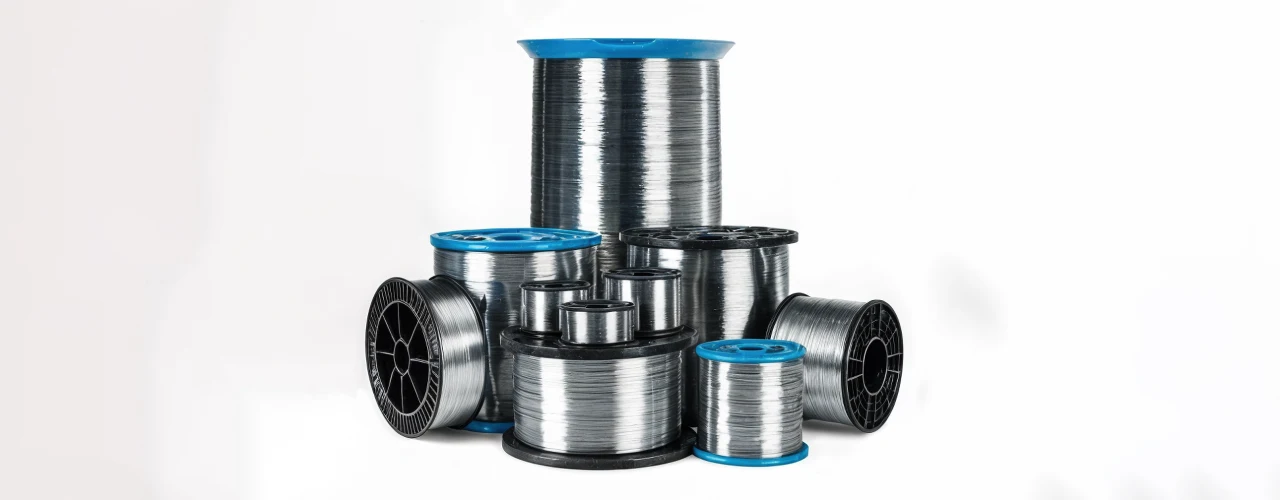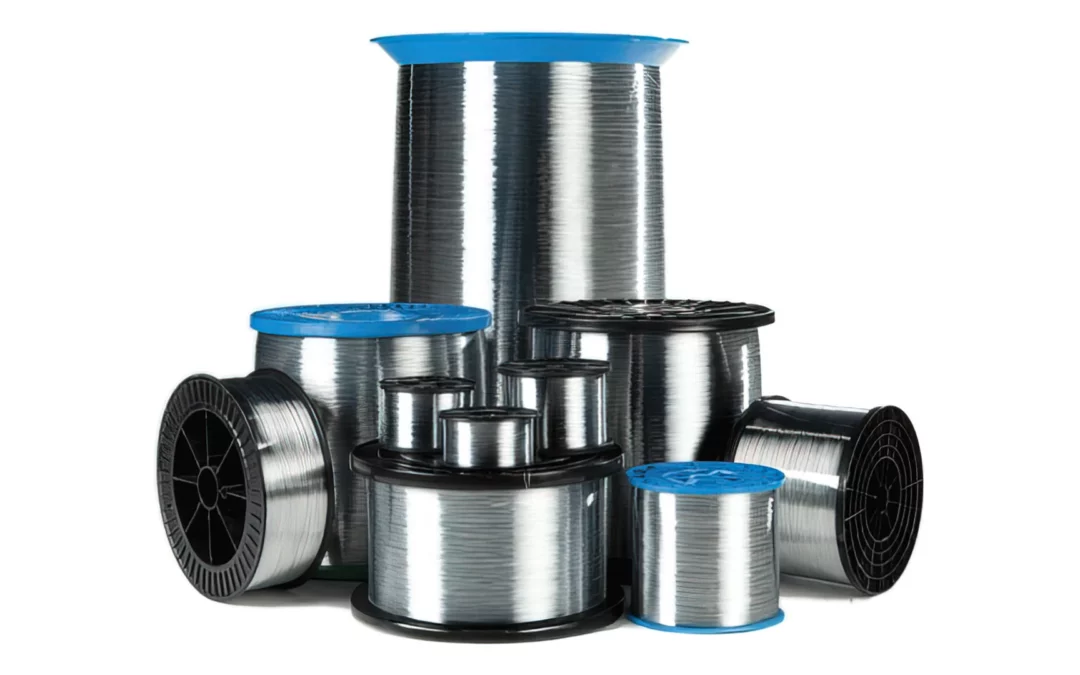Stitching Wire
Stitching Wire
WCJ Pilgrim is the leading American stitching wire manufacturer with decades of experience working with the commercial printing, publishing, and bookbinding sectors to deliver durable high-quality wire to a wide variety of specifications. Stitching wire is a low-carbon steel wire with either a galvanized zinc or tin-coated finish to prevent corrosion. As an experienced stitching wire manufacturer, WCJ Pilgrim can help you find the right stitching wire and appropriate volume for your application.

Quality of Finish
A premium stitching wire manufacturer is only as good as the quality of their finish and WCJ Pilgrim wire excels at providing customers with a premium stitching wire with a chrome-like appearance. With special friction-reducing additives, WCJ Pilgrim stitching wire is exceptional at resisting peeling and flaking with superior workability for all bending or forming processes.
Cast & Camber (Helix)
A great stitching wire, like the ones produced at WCJ’s facility in York, PA is not entirely straight. Each spool has a desired wire curvature and these specifications are known independently as the cast (radial or circular curvature), and the camber (axial curvature component). A large cast and a small camber are indicative of a high-quality stitching wire as this will allow a smoother transition to the stitching head with less drag and fewer dropped stitches.
Wire Tensile
Wire tensile refers to the specific force required to break the wire. Measured in pounds per square inch (PSI), the higher the breaking point, the stiffer the stitching wire. A high-quality product made by a trusted stitching wire manufacturer like WCJ Pilgrim will test between 135,000 and 165,000 PSI. Anything above this range will prematurely wear the stitching head and lead to unnecessary maintenance or downtime. Stitching wire with a tensile strength below 135,000 will be too soft and fail to provide a proper stitch.
Path of Wire
Providing a clear and clean path for the stitching wire to travel from the spool to the stitching head is critical to the overall stitching outcome. If not adequately protected, the stitching wire can easily chip, scratch, or become damaged by exposed brackets or worn wire guides. The wire path must receive consistent attention and regular maintenance. Flat spots on springs or guides and dirty felt pads can result in flaking issues that will jam stitching heads and cause production delays.
The Right Size Stitching Wire for the Job
The majority of the stitching wire used in today’s binderies and in-line stitching operations is 24 and 25 gauge. The difference in size from 24 Gauge (.023”) to 25 gauge (.0204”) is .0026”. This small amount may seem insignificant, but means a lot in terms of yield. A 24 Gauge wire has 8,496 inches per pound of wire and 25 Gauge has 10,800 inches per pound. This amounts to a 21.3% difference in product yield, which translates into 21.3% more staples if you use 25 Gauge over 24 Gauge. In simpler terms, if you imagine a staple or stitch being 1 inch, you would have 2,304 more staples by using the 25 Gauge wire over 24 Gauge.
For example, a 25 gauge stitching wire’s recommended thickness of work is 1/16 to 7/32 of an inch. Whereas a 24 gauge stitching wire’s recommended thickness of work is 1/16 – ¼ of an inch. These are only suggestions as paper type, density, coatings, and stitcher setup can change the stitching wire size required. We recommend physically inspecting the size of your stitching wire and don’t believe what is on the label until you are sure. An oversized wire that is labeled 25 gauge but is actually larger means you are not getting what you are paying for. Oversized wire substantially affects the yield of your wire along with increasing the amount you end up paying at the post office in postage.
Round Bookbinding Wire
| Gauge No. | Size | Inches per lb. | mm | Feet per lb. | 3/4 | 7/8 | 1 | 1 1/4 | 1 1/2 | 1 3/4 | 2 | 2 1/4 | 2 1/2 | 2 3/4 | 3 | 3 1/4 | 3 1/2 |
|---|---|---|---|---|---|---|---|---|---|---|---|---|---|---|---|---|---|
| 16 | 0.063 | 1168 | 1.6 | 97 | 1560 | 1335 | 1168 | 934 | 779 | 669 | 584 | 519 | 467 | 425 | 389 | 359 | 334 |
| 17 | 0.054 | 1536 | 1.4 | 128 | 2048 | 1755 | 1365 | 1228 | 1024 | 877 | 768 | 682 | 614 | 559 | 512 | 473 | 439 |
| 18 | 0.0475 | 1992 | 1.2 | 166 | 2656 | 2276 | 1992 | 1593 | 1328 | 1138 | 996 | 885 | 796 | 724 | 664 | 613 | 569 |
| 19 | 0.041 | 2676 | 1.05 | 223 | 3566 | 3058 | 2676 | 2141 | 1784 | 1529 | 1338 | 1189 | 1070 | 973 | 892 | 823 | 764 |
| 20 | 0.0348 | 3708 | 0.9 | 309 | 4944 | 4238 | 3708 | 2966 | 2472 | 2119 | 1654 | 1648 | 1683 | 1349 | 1236 | 1141 | 1060 |
| 21 | 0.032 | 4440 | 0.8 | 370 | 5920 | 5074 | 4440 | 3552 | 2960 | 2537 | 2220 | ||||||
| 22 | 0.028 | 5820 | 0.7 | 485 | 7760 | 6651 | 5820 | 4656 | 3880 | 3325 | 2910 | ||||||
| 23 | 0.0258 | 6756 | 0.65 | 563 | 9008 | 7721 | 6756 | 5405 | 4504 | 3860 | 3378 | ||||||
| 24 | 0.023 | 8496 | 0.6 | 708 | 11194 | 9709 | 8496 | 6797 | 5664 | 4854 | 4248 | ||||||
| 25 | 0.0217 | 9684 | 0.55 | 807 | 12912 | 11067 | 9684 | 7747 | 6456 | 5534 | 4842 | ||||||
| 26 | 0.0204 | 10800 | 0.51 | 900 | 14400 | 12343 | 10800 | 8640 | 7200 | 6170 | 5400 | ||||||
| 27 | 0.0181 | 14064 | 0.45 | 1172 | 18752 | 16075 | 14064 | 11250 | |||||||||
| 28 | 0.0162 | 15840 | 0.41 | 1320 | 21120 | 18102 | 15840 | ||||||||||
| 29 | 0.0157 | 17796 | 0.4 | 1483 | 23728 | 20338 | 17796 | ||||||||||
| 30 | 0.014 | 23280 | 0.35 | 1940 | 31040 | 26605 | 23280 |
Flat Bookbinding Wire
| Gauge No. | Size | Inches per lb. | Feet per lb. | 3/4 | 7/8 | 1 | 1 1/4 | 1 1/2 | 1 3/4 | 2 | 2 1/4 | 2 1/2 | 2 3/4 | 3 | 3 1/4 | 3 1/2 |
|---|---|---|---|---|---|---|---|---|---|---|---|---|---|---|---|---|
| 18x20 | .047x.035 | 2544 | 212 | 3392 | 2907 | 2544 | 2035 | 1696 | 1452 | 1272 | 1130 | 1018 | 925 | 848 | 783 | 726 |
| 19x21.5 | .041x.030 | 3396 | 283 | 4528 | 3881 | 3396 | 2717 | 2384 | 1940 | 1698 | 1509 | 1358 | 1235 | 1182 | ||
| 20x24 | .035x.023 | 4896 | 408 | 8528 | 5595 | 4896 | 3917 | 3264 | 2798 | 2448 | 2176 | 1958 | 1760 | 1760 | ||
| 20x25 | .035x.021 | 5448 | 454 | 7254 | 6221 | 5448 | 4359 | 3632 | 3110 | 2724 | 2421 | 2180 | ||||
| 21x25 | .032x.021 | 6708 | 559 | 8944 | 7665 | 6708 | 5366 | 4272 | 3823 | 3354 | 2981 | 2683 |
Industries
Industrial
WCJ Pilgrim offers high-quality and durable wires for industrial applications. Including bright or uncoated, as well as the widest range of electroplated wires available in the USA.
Graphic Arts
WCJ Pilgrim Wire manufactures and distributes low-carbon stitching, spiral binding, and other essential wires for use in the graphic arts or publication industries.
Waste Disposal
Many customers rely on WCJ’s single loop and boxed Baling Wire for their in-house box bundling and waste disposal needs.
Medical
WCJ Pilgrim provides high-quality wires essential to the production of medical equipment, technology, and surgical instruments.
Brush & Broom
Our premium wire products are essential components for commercial manufacturers of assorted brushes, brooms, and mops.
Ducting
Ducting wire forms the skeletal structure of adjustable tubed ducting for use in venting appliances, heating systems, or other HVAC applications.
Food
Food-grade wire meets all necessary industry standards and is critical to several aspects of food production, transportation, and storage.
Transportation
WCJ Pilgrim serves the transportation industry by providing durable and reliable wire used in critical components in vehicles.
